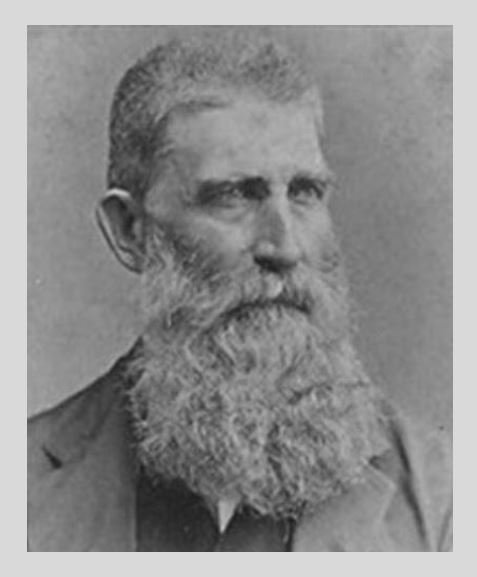J. W. Dant
Joseph Washington Dant was born in May 1820 in Loretto, Kentucky, into a farm family. He received some elementary education, and his first occupation was as a blacksmith. Joseph decided whiskey held more promise at sixteen than beating hot iron and making horseshoes. Dant would marry his wife, Ann Catherine Ballard, on February 12th, 1849. Together, J. W. and Ann Catherine would have ten children, several of whom were sons who would also play a considerable role in distilling. In 1836, Dant established his distillery at Dant Station, Kentucky, and this helped establish Dant's enduring legacy in the bourbon industry.
J. W. Dant was a key figure in American bourbon history, known for his bourbon production and for developing the "log still" distillation technique. He laid the foundation for many modern distilling techniques. One of the most significant challenges for Dant was the scarcity of materials essential for distilling whiskey. At the time, copper was rare and expensive due to British monopolies over smelting and refining, making it challenging for distillers to acquire copper stills. Many distillers, including Dant, turned to alternative methods, using his "log still" distillation technique to circumvent this issue. Dant used hollowed-out logs with copper piping to distill bourbon, a solution for early distillers lacking the resources to afford traditional stills. Dant's use of this technique contributed to the evolution of bourbon production, enabling early distillers to produce quality whiskey with limited resources. This method symbolized resourcefulness and laid the groundwork for future distillation techniques.
J. W. Dant's farming practices were integral to the quality of his whiskey, reflecting his commitment to producing a high-caliber product. His meticulous approach to farming included several key factors that directly influenced the characteristics of his bourbon. Dant grew his grain, primarily corn, the main ingredient in bourbon. By cultivating the crops himself, he could select only the highest quality grains for distillation, ensuring that the foundational element of his whiskey was of superior grade. He was known for handpicking the best grains for his whiskey production, which allowed him to maintain strict quality control. Dant's agricultural practices were grounded in sustainability. By rotating crops and managing soil health, he enhanced the nutrient content of the soil, which in turn nurtured better grain yields. The high-quality grains led to more consistent fermentation processes. When the mash bill is composed of superior grains, it enables consistent yeast activity, leading to better fermentation outcomes. Dant also made his cooperage, which allowed him to maintain strict quality control when barrel aging.
Dant was determined to expand his distillery business. Kentucky was blessed with many navigable rivers, and it was easier to load trade goods like whiskey on a flatboat and send them downriver. This was a better means of transporting a load of whiskey than on mules or wagons and sending them overland to the markets on the east coast. New Orleans was the downriver destination, with a port to take whiskey and other trade goods to European markets and the East Coast. He would cart barrels of whiskey by wagon to the Beech Fork River, build a raft, and float it down the Mississippi to New Orleans.
Dant's whiskey reputation grew over the years. By 1870, he had sufficient resources to build a state-of-the-art distillery. The principle of gravity was used to design and build his new distillery. He placed his mash tubs much higher than the fermenters, and he could fill them with a pipe without needing to pump. Gravity was also employed in the bottling process as the whiskey flowed by gravity to a holding tank and then to the bottling line. Dant's distillation methods evolved, influencing the development of hybrid stills, pot stills, and barrel-aging techniques.
During the 1880s, Dant retired from the distillery business. He turned the management and operations over to his son, Wallace, and younger brother, George. Joseph Washington Dant died in February 1902 and was buried in St. Francis Cemetery of Marion County, Kentucky.
J.W. Dant's contributions have inspired a resurgence in traditional distilling methods and a focus on craftsmanship in the bourbon industry. Modern distilleries, like Log Still Distillery, have revived Dant's techniques and heritage, further cementing his influence in bourbon's cultural and historical narratives. By referencing Dant's log still method, distilleries emphasize their adherence to traditional practices. This commitment to heritage allows distillers to convey a story that resonates with consumers. This narrative positions their whiskey within the context of history, enhancing consumer perception and creating a deeper emotional connection with the product.
Contributed by:Harry Casazza, Berkeley Heights, New Jersey





